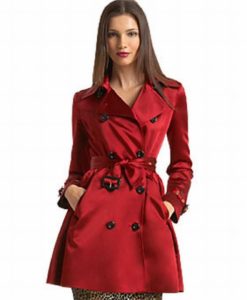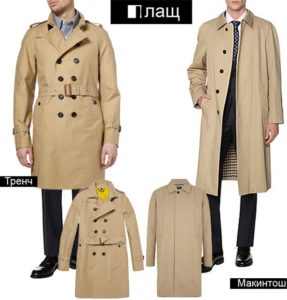 Fashion is fickle, and many items of clothing lose relevance and are forgotten a few years after the peak of popularity.
Fashion is fickle, and many items of clothing lose relevance and are forgotten a few years after the peak of popularity.
But the trench coat is not like that: it has become an eternal classic.
Trench coats began to be worn at the beginning of the 20th century, and they are still often seen both on catwalks and on the street. The secret to the popularity of the trench coat is its comfort and compatibility with items of almost any cut and style.
The popular model is often confused with a raincoat. Let's figure out how one option differs from the other.
What is a trench coat
How the name came about
 The trench coat appeared during the First World War and was originally a soldier's clothing. It was created as a more convenient replacement for a heavy twill overcoat. The new raincoat was supposed to repel water and not restrict movement due to its shorter length compared to the overcoat.
The trench coat appeared during the First World War and was originally a soldier's clothing. It was created as a more convenient replacement for a heavy twill overcoat. The new raincoat was supposed to repel water and not restrict movement due to its shorter length compared to the overcoat.
Reference. The word “trench coat” was formed from the words trench and coat - “trench coat”.
The invention turned out to be convenient. Soon civilians also appreciated this - Coco Chanel introduced him to the world of fashion.
The modern trench coat has retained the attributes of the militaristic modelAnd. It is still double-breasted (in the classic version there should be ten buttons), with epaulettes, cuffs, a turn-down collar, and a belt with a buckle. There is a slit at the back that can be fastened if desired.
Cut
The silhouette of the trench coat has not undergone significant changes since its creation. But still, fashion designers offer a variety of styles for any type of figure.

A trench coat can be:
- classic - straight, slightly fitted, to mid-thigh;
- trapezoidal;
- straight or fitted, with flared hem;
- hybrid: shortened, elongated, with puffy sleeves, a hood, or a combination of all these elements.
The choice of colors and finishes is also rich. In addition to plain ones, there are checkered ones, decorated with floral or graphic patterns and prints, with lace or fur.
In the autumn-winter period, a long model is convenient - it will better protect from the wind. Short trench coats (knee-length and above) are suitable for warm weather.
Material

Originally, trench coats were made from gabardine, but now a variety is available here. In addition to wool, it can be silk, suede, leather, cotton fabric with waterproof impregnation. It all depends on the imagination of the fashion designer.
If a trench coat is made to order, the choice of material is based on the time of year. In the cold season, models made of crepe, drape or tweed with a lining are worn; in the summer, you should pay attention to satin or denim.
Reference. There are knitted models - unlike classic trench coats, they do not repel water, but they look impressive.
Colors

There are any colors to suit your taste.
Beige and the so-called “putty color” (off-white) are considered original., but in fact the choice is unlimited.
Young girls often choose bright colors, while older women often choose calm colors.
Universal black color, it is especially good in combination with light trousers and a thin jumper.
Purpose
Trench coats are worn mainly in summer, spring and autumn as a light raincoat. Despite its lightness, it protects from wind and rain due to the features of the material and the raised collar.
The trench coat was created to make the lives of soldiers more comfortable. And it still successfully performs the same functions in relation to ordinary people.
The trench coat is universal. It goes well with trousers, long and short skirts, even jeans, business style and casual items.
Important! If the skirt is shorter than the trench coat, it is worn unbuttoned.
Often a trench coat is worn not buttoned up, but simply with a belt tied (there is no need to use a buckle, the belt is simply tied) - this gives the image a slight negligence.
Trench or raincoat

Strictly speaking, a trench coat is a type of raincoat that has some special features.
On my own the cloak can be anything. There are styles with and without a collar, short and ankle-length, single-breasted and double-breasted, with buttons, zippers and without fasteners. It would seem that there are many similarities between the models. But the difference is obvious.
Important! Only a coat that has all the features of the model can be called a trench coat: epaulettes, a belt buckle, buttons, a turn-down collar.
There are styles that are close to trench coats, but have differences - for example, without sleeves or belts, significantly shorter (“trench jacket” or “trench jacket”).
Undoubtedly, designers were inspired by trench coats to create such models, but they are far from classic.
The lightest trench coats are worn not as outerwear, but as dresses - this is also a variation on the classic theme.


 0
0





